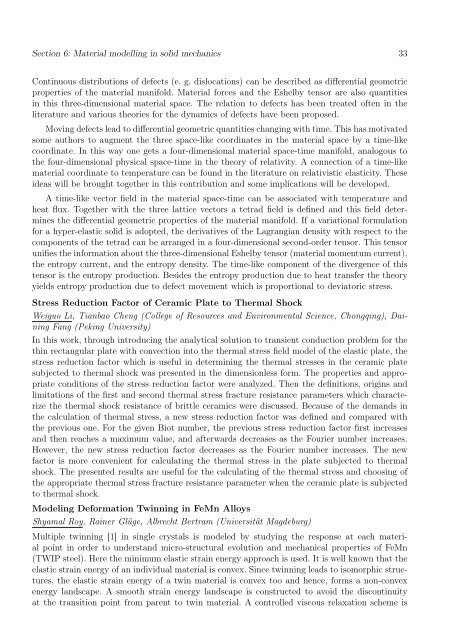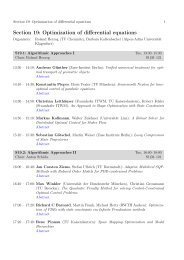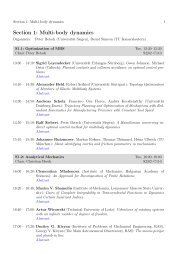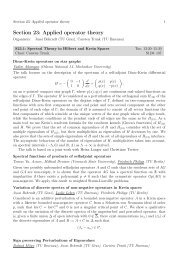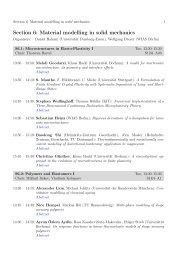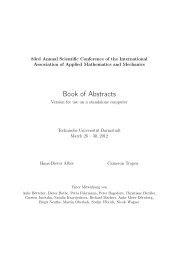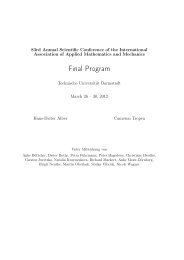Section 6: Material modelling in solid mechanics - GAMM 2012
Section 6: Material modelling in solid mechanics - GAMM 2012
Section 6: Material modelling in solid mechanics - GAMM 2012
You also want an ePaper? Increase the reach of your titles
YUMPU automatically turns print PDFs into web optimized ePapers that Google loves.
<strong>Section</strong> 6: <strong>Material</strong> <strong>modell<strong>in</strong>g</strong> <strong>in</strong> <strong>solid</strong> <strong>mechanics</strong> 33<br />
Cont<strong>in</strong>uous distributions of defects (e. g. dislocations) can be described as differential geometric<br />
properties of the material manifold. <strong>Material</strong> forces and the Eshelby tensor are also quantities<br />
<strong>in</strong> this three-dimensional material space. The relation to defects has been treated often <strong>in</strong> the<br />
literature and various theories for the dynamics of defects have been proposed.<br />
Mov<strong>in</strong>g defects lead to differential geometric quantities chang<strong>in</strong>g with time. This has motivated<br />
some authors to augment the three space-like coord<strong>in</strong>ates <strong>in</strong> the material space by a time-like<br />
coord<strong>in</strong>ate. In this way one gets a four-dimensional material space-time manifold, analogous to<br />
the four-dimensional physical space-time <strong>in</strong> the theory of relativity. A connection of a time-like<br />
material coord<strong>in</strong>ate to temperature can be found <strong>in</strong> the literature on relativistic elasticity. These<br />
ideas will be brought together <strong>in</strong> this contribution and some implications will be developed.<br />
A time-like vector field <strong>in</strong> the material space-time can be associated with temperature and<br />
heat flux. Together with the three lattice vectors a tetrad field is def<strong>in</strong>ed and this field determ<strong>in</strong>es<br />
the differential geometric properties of the material manifold. If a variational formulation<br />
for a hyper-elastic <strong>solid</strong> is adopted, the derivatives of the Lagrangian density with respect to the<br />
components of the tetrad can be arranged <strong>in</strong> a four-dimensional second-order tensor. This tensor<br />
unifies the <strong>in</strong>formation about the three-dimensional Eshelby tensor (material momentum current),<br />
the entropy current, and the entropy density. The time-like component of the divergence of this<br />
tensor is the entropy production. Besides the entropy production due to heat transfer the theory<br />
yields entropy production due to defect movement which is proportional to deviatoric stress.<br />
Stress Reduction Factor of Ceramic Plate to Thermal Shock<br />
Weiguo Li, Tianbao Cheng (College of Resources and Environmental Science, Chongq<strong>in</strong>g), Da<strong>in</strong><strong>in</strong>g<br />
Fang (Pek<strong>in</strong>g University)<br />
In this work, through <strong>in</strong>troduc<strong>in</strong>g the analytical solution to transient conduction problem for the<br />
th<strong>in</strong> rectangular plate with convection <strong>in</strong>to the thermal stress field model of the elastic plate, the<br />
stress reduction factor which is useful <strong>in</strong> determ<strong>in</strong><strong>in</strong>g the thermal stresses <strong>in</strong> the ceramic plate<br />
subjected to thermal shock was presented <strong>in</strong> the dimensionless form. The properties and appropriate<br />
conditions of the stress reduction factor were analyzed. Then the def<strong>in</strong>itions, orig<strong>in</strong>s and<br />
limitations of the first and second thermal stress fracture resistance parameters which characterize<br />
the thermal shock resistance of brittle ceramics were discussed. Because of the demands <strong>in</strong><br />
the calculation of thermal stress, a new stress reduction factor was def<strong>in</strong>ed and compared with<br />
the previous one. For the given Biot number, the previous stress reduction factor first <strong>in</strong>creases<br />
and then reaches a maximum value, and afterwards decreases as the Fourier number <strong>in</strong>creases.<br />
However, the new stress reduction factor decreases as the Fourier number <strong>in</strong>creases. The new<br />
factor is more convenient for calculat<strong>in</strong>g the thermal stress <strong>in</strong> the plate subjected to thermal<br />
shock. The presented results are useful for the calculat<strong>in</strong>g of the thermal stress and choos<strong>in</strong>g of<br />
the appropriate thermal stress fracture resistance parameter when the ceramic plate is subjected<br />
to thermal shock.<br />
Model<strong>in</strong>g Deformation Tw<strong>in</strong>n<strong>in</strong>g <strong>in</strong> FeMn Alloys<br />
Shyamal Roy, Ra<strong>in</strong>er Glüge, Albrecht Bertram (Universität Magdeburg)<br />
Multiple tw<strong>in</strong>n<strong>in</strong>g [1] <strong>in</strong> s<strong>in</strong>gle crystals is modeled by study<strong>in</strong>g the response at each material<br />
po<strong>in</strong>t <strong>in</strong> order to understand micro-structural evolution and mechanical properties of FeMn<br />
(TWIP steel). Here the m<strong>in</strong>imum elastic stra<strong>in</strong> energy approach is used. It is well known that the<br />
elastic stra<strong>in</strong> energy of an <strong>in</strong>dividual material is convex. S<strong>in</strong>ce tw<strong>in</strong>n<strong>in</strong>g leads to isomorphic structures,<br />
the elastic stra<strong>in</strong> energy of a tw<strong>in</strong> material is convex too and hence, forms a non-convex<br />
energy landscape. A smooth stra<strong>in</strong> energy landscape is constructed to avoid the discont<strong>in</strong>uity<br />
at the transition po<strong>in</strong>t from parent to tw<strong>in</strong> material. A controlled viscous relaxation scheme is


